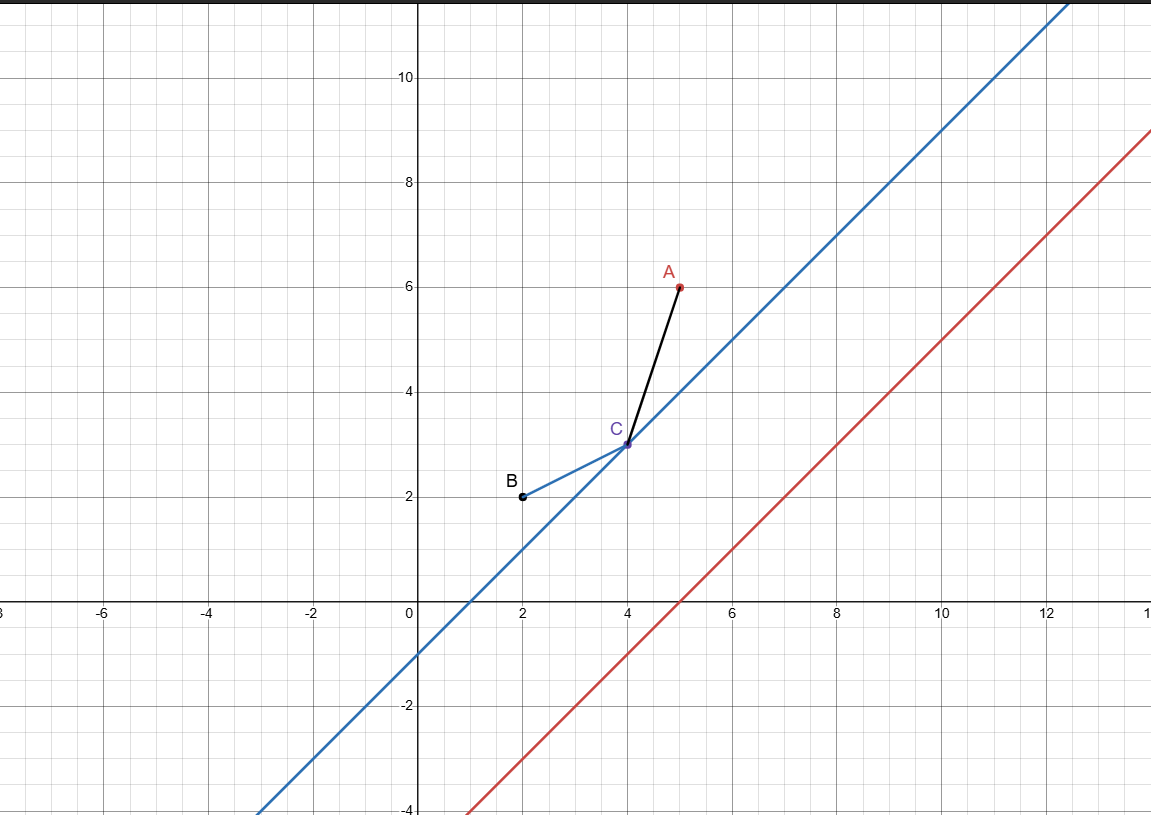题意
给出一个网络,求流量的最大值
sol
网络流板子题。
网络流是 OI 中比较常用的算法之一,以较高的建图难度深受出题人喜爱,不过近几年题目数量减少。
当然,在学习建图之前,需要先学会网络流的板子。
一些定义
(部分摘自 OI-Wiki)
网络是特殊的有向图 \(G=(V,E)\);
源点 \(s\) 是网络的起点,汇点 \(t\) 是网络的终点,\(s,t \in V\);
对于\(\forall (u,v) \in E\),其容量为 \(c(u,v)\),特别的,若 \((u,v) \notin E\),\(c(u,v) = 0\)
对于\(\forall (u,v) \in E\),其流量为 \(f(u,v)\),且满足以下性质:
- \(\forall (u,v) \in E, 0\le f(u,v) \le c(u,v)\)
- \(\forall u \in V - \{s,t\}, \sum_{x\in V} f(u,x) = \sum_{x\in V} f(x,u)\)
对于一个网络上的一个流,我们定义其流量 \(|f|=\sum_{x\in V} f(s,x) - \sum_{x\in V} f(x,s)\)
对于一个网络 \(G\),若 \(S\cap T=V\) 且 \(S\cup T=\varnothing\) 且 \(s \in S,t \in T\),则 {S,T} 是 \(G\) 的一个割,其容量 \(||S,T||=\sum_{u\in S}\sum_{v\in T} c(u,v)\)
对于网络 \(G\),其可能的最大的流量 \(f\) 即为 \(G\) 的最大流
Edmond-Karp
在残量网络中 BFS 找到一条增广路(从源点到汇点容量为正的路径),累加流量,最后更新残量网络。
理论复杂度上限 \(O(nm^2)\),实际可处理 \(10^3 \sim 10^4\) 的数据
代码:
#include <iostream>
#include <algorithm>
#include <cstring>
#include <queue>using namespace std;
typedef unsigned int UI;
typedef long long LL;constexpr int N = 205, M = 10005;
constexpr UI INF = 1 << 31;int h[N], e[M], f[M], ne[M], idx;
int pre[N];
UI d[N];
bool st[N];
int n, m, S, T;void add(int a, int b, int c){e[idx] = b, f[idx] = c, ne[idx] = h[a], h[a] = idx ++ ;e[idx] = a, f[idx] = 0, ne[idx] = h[b], h[b] = idx ++ ;
}bool BFS(){memset(st, false, sizeof st);queue<int> q;st[S] = true, d[S] = INF;q.push(S);while (!q.empty()) {int t = q.front();q.pop();for (int i = h[t]; ~i; i = ne[i]){int j = e[i];if (!st[j] && f[i]) {st[j] = true;pre[j] = i;d[j] = min(d[t], (UI) f[i]);if (j == T) return true;q.push(j);}}}return false;
}LL EK(){LL res = 0;while (BFS()) {res += d[T];for (int u = T; u != S; u = e[pre[u] ^ 1]) f[pre[u]] -= d[T], f[pre[u] ^ 1] += d[T];}return res;
}int main(){scanf("%d%d%d%d", &n, &m, &S, &T);memset(h, -1, sizeof h);while (m -- ){int a, b, c;scanf("%d%d%d", &a, &b, &c);add(a, b, c);}printf("%lld\n", EK());return 0;
}
Dinic
在残量网络中进行分层(防止出现环),然后爆搜每一条增广路,如果可行的话就累加
注意一部分优化:
- 在爆搜的过程中,如果发现当前节点的流出流量已经超过流入流量,则直接返回
- 在爆搜的过程中,如果发现某个节点无法提供任何流量,那么就在这个残量网络中删除这个节点
- 在爆搜的过程中,如果重复遍历某个点,那么继续上一次未搜索完的弧遍历(当前弧优化)
理论复杂度上限 \(O(n^2m)\),实际可处理 \(10^4 \sim 10^5\) 的数据。
代码
#include <iostream>
#include <algorithm>
#include <cstring>
#include <queue>using namespace std;
typedef unsigned int UI;const int N = 1205, M = 240005;
const UI INF = 1 << 31;int h[N], e[M], ne[M], idx;
UI f[M];
int d[N], cur[N];
int n, m, S, T;void add(int a, int b, int c){e[idx] = b, f[idx] = c, ne[idx] = h[a], h[a] = idx ++ ;e[idx] = a, f[idx] = 0, ne[idx] = h[b], h[b] = idx ++ ;
}bool bfs(){memset(d, -1, sizeof d);queue<int> q;q.push(S), d[S] = 0, cur[S] = h[S];while (!q.empty()) {int t = q.front(); q.pop();for (int i = h[t]; ~i; i = ne[i]){int j = e[i];if (d[j] == -1 && f[i]) {d[j] = d[t] + 1;cur[j] = h[j];if (j == T) return true;q.push(j);}}}return false;
}UI find(int u, UI limit) {if (u == T) return limit;UI flow = 0;for (int i = cur[u]; ~i && flow < limit; i = ne[i]){ // 优化 1cur[u] = i; // 优化 3int j = e[i];if (d[j] == d[u] + 1 && f[i]) {int t = find(j, min(limit - flow, f[i]));if (!t) d[j] = -1; // 优化 2f[i] -= t, f[i ^ 1] += t, flow += t;}}return flow;
}int dinic(){int res = 0, flow;while (bfs()) while (flow = find(S, INF)) res += flow;return res;
}int main(){scanf("%d%d%d%d", &n, &m, &S, &T);memset(h, -1, sizeof h);while (m -- ){int a, b, c;scanf("%d%d%d", &a, &b, &c);add(a, b, c);}printf("%d\n", dinic());
}
Dinic 算法在大部分题目中都够用,因为卡 Dinic 是没有浮木的行为。
此外还有效率差不多的 ISAP 算法和相对更快的 HLPP 算法(理论上届复杂度 \(O(n^2\sqrt{m})\)),但是不会。










